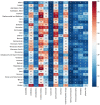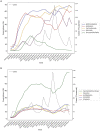Drug prescription patterns and their association with mortality and hospitalization duration in COVID-19 patients: insights from big data
- PMID: 38164450
- PMCID: PMC10758044
- DOI: 10.3389/fpubh.2023.1280434
Drug prescription patterns and their association with mortality and hospitalization duration in COVID-19 patients: insights from big data
Abstract
Background: Different medication prescription patterns have been associated with varying course of disease and outcomes in COVID-19. Health claims data is a rich source of information on disease treatment and outcomes. We aimed to investigate drug prescription patterns and their association with mortality and hospitalization via insurance data for a relatively long period of the pandemic in Iran.
Methods: We retrieved hospitalized patients' data from Iran Health Insurance Organization (IHIO) spanning 26 months (2020-2022) nationwide. Included were patients with ICD-10 codes U07.1/U07.2 for confirmed/suspected COVID-19. A case was defined as a single hospitalization event for an individual patient. Multiple hospitalizations of a patient within a 30-day interval were aggregated into a single case, while hospitalizations with intervals exceeding 30 days were treated as independent cases. The Anatomical Therapeutic Chemical (ATC) was used for medications classification. The two main study outcomes were general and intensive care unit (ICU) hospitalization periods and mortality. Besides, various demographic and clinical associate factors were analyzed to derive the associations with medication prescription patterns and study outcomes using accelerated failure time (AFT) and logistic regression models.
Results: During the 26 months of the study period, 1,113,678 admissions with COVID-19 diagnosis at hospitals working in company with IHIO were recorded. 917,198 cases were detected from the database, among which 51.91% were females and 48.09% were males. Among the main groups of medications, antithrombotics (55.84% [95% CI: 55.74-55.94]), corticosteroids (54.14% [54.04-54.24]), and antibiotics (42.22% [42.12-42.32]) were the top used medications among cases with COVID-19. Investigation of the duration of hospitalization based on main medication groups showed antithrombotics (adjusted median ratio = 0.94 [0.94-0.95]) were significantly associated with shorter periods of overall hospitalization. Also, antithrombotics (adjusted odds ratio = 0.74 [95%CI, 0.73-0.76]), corticosteroids (0.97 [0.95-0.99]), antivirals (0.82 [0.80-0.83]), and ACE inhibitor/ARB (0.79 [0.77-0.80]) were significantly associated with lower mortality.
Conclusion: Over 2 years of investigation, antithrombotics, corticosteroids, and antibiotics were the top medications for hospitalized patients with COVID-19. Trends in medication prescription varied based on various factors across the country. Medication prescriptions could potentially significantly impact the trends of mortality and hospitalization during epidemics, thereby affecting both health and economic burdens.
Keywords: COVID-19; claims data; drug prescriptions; electronic health records; mortality.
Copyright © 2023 Mehrizi, Golestani, Malekpour, Karami, Nasehi, Effatpanah, Ranjbaran, Shahali, Sari and Daroudi.
Conflict of interest statement
The authors declare that the research was conducted in the absence of any commercial or financial relationships that could be construed as a potential conflict of interest.
Figures






Similar articles
-
Patterns of case fatality and hospitalization duration among nearly 1 million hospitalized COVID-19 patients covered by Iran Health Insurance Organization (IHIO) over two years of pandemic: An analysis of associated factors.PLoS One. 2024 Feb 23;19(2):e0298604. doi: 10.1371/journal.pone.0298604. eCollection 2024. PLoS One. 2024. PMID: 38394118 Free PMC article.
-
Treatment Initiation Patterns, Modifications, and Medication Adherence Among Newly Diagnosed Heart Failure Patients: A Retrospective Claims Database Analysis.J Manag Care Spec Pharm. 2016 May;22(5):561-71. doi: 10.18553/jmcp.2016.22.5.561. J Manag Care Spec Pharm. 2016. PMID: 27123917 Free PMC article.
-
Outcomes of Hospitalized COVID-19 Patients Receiving Renin Angiotensin System Blockers and Calcium Channel Blockers.Am J Nephrol. 2021;52(3):250-260. doi: 10.1159/000515232. Epub 2021 Apr 7. Am J Nephrol. 2021. PMID: 33827074 Free PMC article.
-
Effect of continuing the use of renin-angiotensin system inhibitors on mortality in patients hospitalized for coronavirus disease 2019: a systematic review, meta-analysis, and meta-regression analysis.BMC Infect Dis. 2023 Jan 24;23(1):53. doi: 10.1186/s12879-023-07994-7. BMC Infect Dis. 2023. PMID: 36694122 Free PMC article.
-
Association between COVID-19 Mortality and Underlying Disease; Tehran, Iran.J Caring Sci. 2024 Jun 2;14(1):37-41. doi: 10.34172/jcs.025.33254. eCollection 2025 Feb. J Caring Sci. 2024. PMID: 40391312 Free PMC article. Review.
Cited by
-
The effect of antibiotic therapy on clinical outcome in patients hospitalized with moderate COVID-19 disease: a prospective multi-center cohort study.Infection. 2025 Jun 26. doi: 10.1007/s15010-025-02590-0. Online ahead of print. Infection. 2025. PMID: 40569348
-
A decision rule algorithm for the detection of patients with hypertension using claims data.J Diabetes Metab Disord. 2024 Dec 20;24(1):21. doi: 10.1007/s40200-024-01519-y. eCollection 2025 Jun. J Diabetes Metab Disord. 2024. PMID: 39712338
References
-
- Wise J. Covid-19: WHO declares end of global health emergency. British Medical Journal Publishing Group; (2023). - PubMed
MeSH terms
Substances
LinkOut - more resources
Full Text Sources
Medical
Research Materials
Miscellaneous

